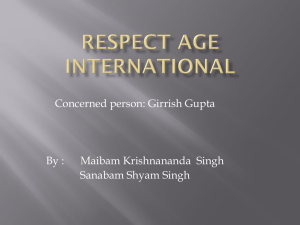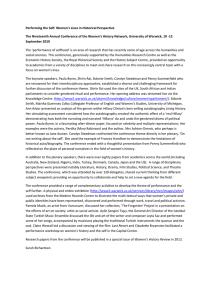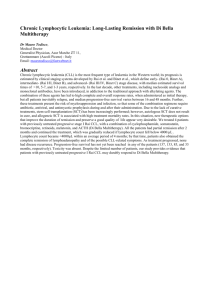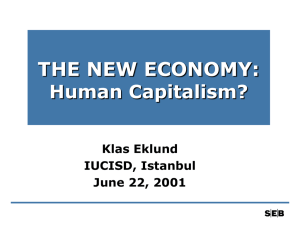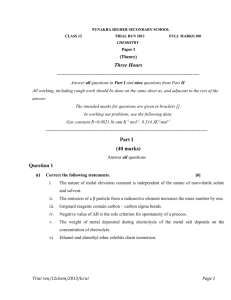Law, Social Justice & Global Development Gender and Globalisation and Women’s
advertisement
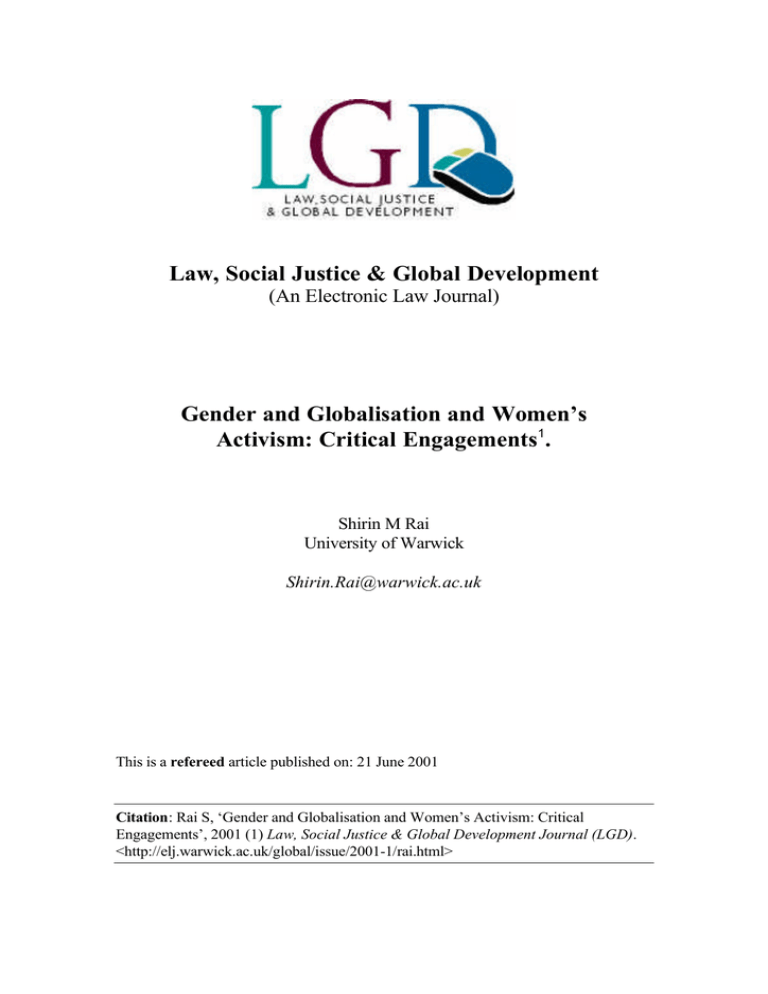
Law, Social Justice & Global Development (An Electronic Law Journal) Gender and Globalisation and Women’s Activism: Critical Engagements1. Shirin M Rai University of Warwick Shirin.Rai@warwick.ac.uk This is a refereed article published on: 21 June 2001 Citation: Rai S, ‘Gender and Globalisation and Women’s Activism: Critical Engagements’, 2001 (1) Law, Social Justice & Global Development Journal (LGD). <http://elj.warwick.ac.uk/global/issue/2001-1/rai.html> Rai S Gender and Globalisation and Women’s Activism: Critical Engagements Abstract There is a growing literature on global restructuring and the growing pressures and inequalities across different social and spatial boundaries. This increase in inequalities has also been accompanied by the decline of class-based movements which have themselves suffered from a failure to recognise social exclusion based on issues other than class. In this paper I argue that if the feminist challenge is not to be limited, there needs to be a focus on the importance of redistributive policies that are rooted in the structural inequalities of capitalist production and exchange. In this situation alliances between women’s and other social groups and solidarity among different emancipatory social movements, which expand the links between gender activism and other forms of transformative politics become both more necessary and more possible. To reach this conclusion I examine an example of an initiative by the Indian government in the province of Rajasthan, the Women’s Development Programme. Keywords: Gender, Global Restructuring, Class, Movement, India, Women’ Development Programme, Rajasthan, Redistributive. 1. Introduction There is a growing literature on global restructuring and the growing pressures and inequalities across different social and spatial boundaries. This increase in inequalities has also been accompanied by the decline of class-based movements which have themselves suffered from a failure to recognise social exclusion based on issues other than class. In this paper I argue that if the feminist challenge is not to be limited, there needs to be a focus on the importance of re-distributive policies that are rooted in the structural inequalities of capitalist production and exchange. Following Spivak, I would argue that a recognition of the importance of redistribution allows us: ‘[b]oth in the economic area (capitalist) and in the political (world-historical agent) ... to construct models of a divided and dislocated subject whose parts are not continuous or coherent with each other’ (Hoskyns and Rai, 1998, p.276). And further, that often these dislocations, and discontinuities are where women seeking transformation within political economy as well as the discursive circuits of power can find agency. I would suggest that: ‘the next phase of women’s struggles needs to take on board more centrally the issue of redistribution of economic and political resources if power relations in society are to be refashioned’ (Hoskyns and Rai, 1998, p.363, see Bina Agarwal’s assessment of the land question, 1995 and Shiva on biopiracy). In this situation alliances between women’s and other social groups and solidarity among different emancipatory social movements, which expand the links between gender activism and other forms of transformative politics become both more necessary and more possible. To reach this conclusion I examine an example of an LGD 2001 Issue 1http://elj.warwick.ac.uk/global/issue/2001-1/rai.htmlRefereed Article Rai S Gender and Globalisation and Women’s Activism: Critical Engagements initiative by the Indian government in the province of Rajasthan, the Women’s Development Programme. 2. Sathin, the State and Social Change Chakravarty’s careful study of the Women’s Development Programme (WDP) elaborates the tension within the women’s movements, NGOs and feminist bureaucrats and academics. It also points to the differences among women’s groups in the ‘South’ which do not allow for easy construction of categories of Third World women. The WDP was launched in 1984 in six districts of Rajasthan, with the assistance of UNICEF. After the 1975 Report on the Status of Women, and the phenomenal growth of the women’s movements in 1970s and 1980s, and the launch of the UN Decade of Women, the Indian State decided on this initiative. The aims included creating: ‘a new sense of worth among poor rural women and facilitating their awareness to develop strategies regarding social and development issues’ (Chakravarty, 1999, p.1-2). This was to be done through mechanisms that were both flexible and diverse. These mechanisms were to focus on improving women’s participation in development schemes, ‘especially [of women] from disadvantaged communities’ (Chakravarty, 1999, p.2). The agents of change in this scheme were the sathins, (the feminine form of the word friend) at the village level, and the pracheta (secular preacher) at the district level. The following agencies participated in the training, communication and monitoring required by the programme: the District Level Women’s Development Agency headed by the District Collector representing the governmental authority; the State Information Development Agency (a voluntary organisation) and the Institute of Development Studies, an autonomous research institute in Jaipur, Rajasthan. The structure was ‘an attempt to balance power between the government and nongovernmental segments’ of the programme, and reflected the concern of a wide range of women’s groups that had been consulted in the process of setting up WDP. While most women’s groups had supported the programme, many had been sceptical about: ‘the possibility of a fruitful collaboration between the state and the women’s movement in any form’ (Chakravarty, 1999, p.3). ‘The sathin was envisaged as a worker with a difference: a catalyst of women’s empowerment at the grassroots. She was to be instrumental in the growth of women’s collective strength, to increase women’s bargaining capacity, and help them to articulate collective interests. ...But the effectiveness of the sathin was predicated upon a transformation within the sathin herself so that she could become, through this process, a woman leader’ (Chakravarty, 1999, p.3-4). Training of the sathin was thus an important element of the programme. At the heart of their work was a commitment to: LGD 2001 Issue 1http://elj.warwick.ac.uk/global/issue/2001-1/rai.htmlRefereed Article Rai S Gender and Globalisation and Women’s Activism: Critical Engagements ‘collective processes, working upwards through first evolving village level platforms for articulating women’s points of view and then moving outwards to other groups of women engaged in similar processes’ (Chakravarty, 1999, p.3). Both practical and strategic interests were identified through this process: from famine relief measures, to combating gross forms of patriarchal and social oppressions, minimum wages, recovery of land from encroachers, issues of widows’ claim to land, employment opportunities for women, safe drinking water and healthcare. The articulation of these interests and mobilisations resulting from these inevitably brought the sathin into conflict with the village social and political hierarchies. As ‘long as the sathins received support from the district agencies, from the voluntary organisations, and through them the government authorities, the sathins were not alone in their activities...The support of the district agencies was a crucial element in women’s confrontations with caste and class oppressions within rural society’ (Chakravarty, 1999, p.5). However, this edifice based on co-operation between multi-level agencies and actors revealed tremendous strains as the government moved to prioritise the ‘family planning’ programme at a time of drought and crop failure in Rajasthan between 1985 and 1988. On the one hand, government run famine relief programmes were the major means of survival for the rural poor, on the other, these programmes were used by local government officials to fulfil their quotas for the sterilisation of women as part of the family planning programme. Local government officials used grain distribution as part of famine relief as an incentive for women and men to get sterilised. The obverse side of this ‘carrot’ was the disincentive of being denied famine relief if the family did not agree to the sterilisation of one partner. It was usually the woman who faced this conundrum most directly. The abuse of famine relief distribution in this way was widespread. Women were caught between these twin pressures. The sathins mobilised opposition to this double oppression with the support of the nongovernmental organisations involved in WDP. The District governmental sector, however, refused to discuss the issue (Chakravarty, 1999, p.7). In a parallel move, the sathins from various villages and districts met in 1986 and identified land and health as the two areas that most needed to be addressed by WDP. As Chakravarty comments: ‘The only aspect of women’s health the state was interested in was that they should stop ‘breeding’. The women who participated in the health camps held in Ajmer District, on the other hand, were concerned with a whole host of issues around their bodies’ (Chakravarty, 1999, p.8). As this dispute on the question of linking family planning and famine relief showed, the alliance between various sectors of governance was a fragile one when competing interests clashed. The state institutions had a powerful position in this dispute. LGD 2001 Issue 1http://elj.warwick.ac.uk/global/issue/2001-1/rai.htmlRefereed Article Rai S Gender and Globalisation and Women’s Activism: Critical Engagements This clash of interests became even more pronounced when the sathins tried to mobilise their resources by organising themselves into a union, and by demanding the ‘regularising’ of their status within the state structure as government employees enjoying security of employment and an adequate wage for their work. In 1990 sathins went on strike on this issue. The government agencies refused their demands stating that the sathins were volunteers, not employees; that they were uneducated and illiterate and therefore could not be government employees. The fact that the WDP had envisioned the participation of poor, low caste women as central to the success of the programme, and that these women could not be educated and literate did not enter into their consciousness. The local government officials, such as the Block Development Officers, even sent letters to the husbands of the sathins instructing them to ‘bring their wives to their senses’ or accept the consequences. Chakravarty comments: ‘From the movement of the sathin around wages and other related issues it is clear that while the sathins had been transformed from being ‘passive recipients’ of development policies the ‘upper’ levels of the WDP had remained class bound and instrumentalist in their approach to the program’ (Chakravarty, 1999, p.11). The tensions resulting from this fracturing of the WDP came to a head with the gruesome gang rape of one sathin - Bhanwari Devi - in 1992. Bhanwari Devi was regarded as overreaching her role as sathin when she approached upper caste women as well as lower caste. She was made an ‘example’ by the local upper caste men to warn off other sathins and to clearly demarcate the limits of their work within the community. In a brave attempt to counter such violence, Bhanwari Devi took the men responsible to court. The social embeddedness of state institutions was clearly visible when the Supreme Court acquitted the rapists on the grounds of: ‘an upper caste man would not disregard caste…differences to rape a low caste woman’ (Chakravarty, 1999, p.16). In the last few years, the sathin programme has been bureaucratised, as well as starved of funds. Chakravarty concludes from this: ‘The government wants empowerment without breaking into the power of those including themselves, who have power over the disempowered...while the sathins struggle...for the statutory minimum wage of workers and the survival and expansion of the scheme, the government claims credit for the ‘success’ of the sathin programme in Beijing, Vienna and Geneva’ (Chakravarty, 1999, p.18). This story raises many questions. For the women’s movements, there is the danger of providing legitimacy to programmes that are not under their control. For international organisations such as the UNICEF there is the question regarding the nature and focus of training provision - by focusing on the training of the sathins and not at the upper echelons of the government hierarchy and the village level political actors, the clash of LGD 2001 Issue 1http://elj.warwick.ac.uk/global/issue/2001-1/rai.htmlRefereed Article Rai S Gender and Globalisation and Women’s Activism: Critical Engagements political cultures becomes inevitable. For the non-governmental organisations and academic institutes there is the question of providing legitimacy to state led programmes, but also of delivering appropriate levels of support for the sathins when and where these were needed. For the sathins there is the real question of levels of risk involved in doing their work without adequate support, as well as of how to translate conscientisation into practical results when the structures of power are supported by political hierarchies at every level. The sathin initiative has now slowed down, and become more closely integrated into governmental programmes. The radical edge of the movement has been worn away, though many courageous women continue to participate in it. What this study illustrates is that despite the brave stand by many individual women, and groups to counter patriarchal oppression through institutional politics, NGOs and women’s movements working with institutions of power at any level are constrained by the dominant paradigms of power. Most of the initiatives taken by these institutions under pressure from women’s groups are ‘integrating’ rather than ‘agenda-setting’ (Jahan,1995). Such integration occurs through the dominance of depoliticised discourses of ‘common sense’ managerialism that needs to take into account the constraints within which policy is implemented. The acceptance of managerial approaches to politics (McMichael, 2000) not only impose limits to change, they also raise the issue of co-option of women’s groups into the hierarchies of power and influence. Co-option is particularly difficult to resist at a local level where the immediacy of caste/class positioning makes negotiation and opposition to established hierarchies highly problematic. 3. The Local as Refugee? This study throws light on a myriad of relationships - between multi-lateral agencies and the state, between the local and state agendas, between women and men of lower and upper castes, and the problems faced by those on the ‘inside’ and those from the ‘outside’. It also fundamentally throws light upon class relations at the local levels and the powerful location that these have within the cultural and historical boundaries of caste politics. In this context I examine the concept of the local and caution against its celebration. It seems to me that at times, the level of theorising of this space is marked by a naive but politically dangerous disregard of the power structures that frame it. The local is of course a critically important space for our daily lives, but precisely because it is so immediate we need to map it more carefully than many of those celebrating it uncritically are able to do. While some analysts have bemoaned the marginalisation of the nation-state, and state elites in the debates on global governance, others have emphasised the emancipatory potential of ‘the local’ in the political economy of globalisation. Many feminists have participated in this celebration of ‘the local’. Where are women most able to participate in struggles to improve their lives, they ask? Participation, a key concept in feminist politics, has been assumed to be most effective at the local level. So much so, that in some countries there have been struggles to institutionalise local level political participation through legislation on the premise that development policy outcomes are sub-optimal when not supported by broad based participation from the social groups LGD 2001 Issue 1http://elj.warwick.ac.uk/global/issue/2001-1/rai.htmlRefereed Article Rai S Gender and Globalisation and Women’s Activism: Critical Engagements targeted by the policy (Robinson, 1998, Blair, 2000). In Bolivia, for example, a Law of Popular Participation became effective in 1994, and in India, under the 73rd and 74th Amendments the village level governance institutions (panchayats) were given greater powers and resources, and a quota of 33 per cent was secured for women’s representation on these re-invigorated institutions. In the debates on political participation of women usually the first agencies held up for scrutiny are at the village level. In the context of globalisation, the emphasis on NGO activity has also brought this political space into focus; the most effective NGOs work at the local levels. The nation-state thus seems at times to be being replaced by the expansion of the local in political discourse. In the following section, I examine this concept of the local - not as a missing link between the nation-state and global governance, but as a problematic terrain which women have to function on, and which affects the ways in which they are able to access the local economy and beyond. It is important to do this in order to see how the debates on post-development and the changing/contracting role of the state are affecting the lives of men and women. If women’s work challenges the divisions between the public and the private, their lives also raise questions about the importance of the local spaces that they occupy. The ‘local’ has found a privileged place in the vocabulary of different groups concerned with issues of development and democracy - basic needs theorists, environmentalists, sustainability groups, feminists, and those intervening in the human rights debate. This has been for several reasons. First, the emphasis on the local allows a critique of nationalist agendas of political elites focused on big projects of industrialisation. As Pearson has commented, these projects assumed the man as worker, and in countries such as Brazil and India, we see rapid industrialisation in the 1960s and 1970s resulting in falling levels of women’s employment in the public sphere (1998). Second, a focus on the local challenges the universalism of scientific discourses upon which the framework of modernisation was built, by pointing to the salience of local knowledge and paradigms: ‘It is local knowledge that informs the birthing skills of the sages-femmes studied by Bohme (1984)....And it is local knowledge produced by workers that is the object of appropriation and control in both Taylorist and ‘postindustrial’ strategies of industrial management’ (Kloppenburg, Jr, 1991, p.14, see also, Berry, 1991, Esteva and Prakash, 1997). The idea of the local is sensitive to the context of peoples lives. ‘Related to the theme of context or locale is the idea of distance which also has social, emotional or geographical dimensions...between authors and subject...[between] First Nation or Diaspora women’ (Marchand and Parpart, 1995, p.77). Third, a focus on the local allows people to participate in the economic and political life of their community: LGD 2001 Issue 1http://elj.warwick.ac.uk/global/issue/2001-1/rai.htmlRefereed Article Rai S Gender and Globalisation and Women’s Activism: Critical Engagements ‘Thousands of small grassroots groups are realising that there is no need to ‘think big’ in order to begin releasing themselves from the clutches of the monopolistic...economy; that they can free themselves in the same voluntary ways as they entered it’ (Esteva and Prakash, 1997, p.280). Fourth, a focus on the local also challenges authoritarianism by promoting decentralisation and autonomy. The local, upon this view, is democratic, inclusive, and the site for feasible politics of resistance to both global and national nodes of power. The recent emphasis on the ‘grassroots’ in the development funding agencies and their agendas is proof of the importance now being attached to the concept. NGOs as part of civil society organisation also find favour within this discourse. The argument here is that the local is not only closer to the lives of people, it is also allows for greater sensitivity to local ecology, it is more accountable, and more participatory (World Bank’s report on Governance, 1994). Finally, a focus on the local also challenges the possessive individualism of the liberal rights discourse by arguing that the universal language of rights cannot capture the complexities of historically rooted cultural practices that empower people at the local level in their communities: ‘In most Latin American, Asian or African villages, collective or communal rights have clear priority over personal or individual rights; legitimate hierarchies (of the elders, for example) have primacy over equality ...; and concrete customs, rather than abstract universalizable laws, support communal bonds and organize social support.’ (Esteva and Prakash, 1997, p.282, see also Sachs, 1997, p.290). The focus on the local has been a powerful challenge to many of the fundamental reference points of development theory and practice. By advocating a decentralisation of power it has tried to make nation-states more accountable, people’s and women’s participation more feasible, the contexts of peoples’ lives more visible, and the universalisms of science less monolithic. However, we need to sound a cautionary note here. This caution is dictated by various concerns. The first is that the privileging of the local space is very often linked to issues of capacity of the national state. It is interesting that the World Bank and the IMF are emphasising the local space at the same time as the economic and political conditionalities they are imposing upon the national state are increasing. The forcing open of national market boundaries is resulting in the reconfiguration of demographic and geographic spaces within countries. This opening up has led in many Third World countries to experience huge migratory flows of populations for the first time. These flows have been inevitably from the countryside to the urban centres. With the establishment of Free Economic Zones, these flows have also seen the huge increase of women migrants. The local space in the countryside has changed enormously, as has the urban landscape. The concept of the local in this context is itself being stretched. What is the locale for the migrant woman? Her home that she has left LGD 2001 Issue 1http://elj.warwick.ac.uk/global/issue/2001-1/rai.htmlRefereed Article Rai S Gender and Globalisation and Women’s Activism: Critical Engagements behind, or her present, which is not home? This displacement is also resulting in increased vulnerabilities for women. Sexual violence, as well as economic exploitation are increasing in many liberalising countries. This is happening in tandem with the whittling away of state-based support infrastructure - hospitals, schools, refuges, and other social services are being closed, cut down, or privatised 2. In this context the question of decentralisation becomes a difficult one. While economic policies are being crafted in international arenas, the consequences are being felt and lived at the local level. The role of the nation-state becomes vital in this context - at times it is complicit in the ‘globalisation’ of society (Robertson, 1992), at others it is a mediator between the local and the global. A shift of focus away from the nation-state means a neglect of the crucial mapping of the nation-state’s role and influence. Second, my caution stems from the discourse of the local itself. I would suggest that for women the village of many Third World countries is not necessarily a space of freedom or security. Indeed, as we saw in the discussion of the Women’s Development Programme in Rajasthan, the levels of culturally validated oppressions, exclusions, violations and surveillance that women experience in villages are extremely high. Marxist materialists have argued that urbanisation resulting from industrialisation will lead to the breaking down of the ascriptive roles in society, which affect women in particularly restrictive ways (Desai, 1985). I would argue that urbanisation, while presenting its own problems and struggles, does afford women a relative freedom of action often denied them in the locales of their villages. I suggest further that the discourse about empowerment through localisation could also be seen to be a Westernised discourse, where, because of comprehensive industrialisation and urbanisation, the local and urban have gone hand in hand since the advent of Second 3 Wave feminism . When this discourse is transposed to the rural local of the majority of the Third World women, different cultural contexts make the valorisation of the concept more problematic. This is not to take away from the importance of the local in the lives of women, but to query the privileging of it as a freer, less distant, more empowering space. It is with such querying that we can put the politics in the local 4 back in, rather than treating it as a homogeneous, co-operative and democratic space . The local is as fractured a space as the national or the global. It has its own hierarchy of power in operation, with the resources to defend existing relations of power, and to suppress dissent. It is also therefore the space where democratic struggles need to be organised; it is not in itself a means of democratising life. I would argue that such a leaking out of politics from concepts serves only to maintain the status quo through instrumental confusion between ends and means. NGO activity has proliferated in recent years. It has been seen as indicative of the lack of capacity of nation-states on the one hand, and the privatisation of social welfare on the other (Arellano-Lopez and Petras, 1994, Craske, 1998). While the unaccountability of states is targeted, that of the NGO sector is largely ignored. Kabeer has suggested that even when NGOs promote gender-sensitivity within their programmes, they often fail to have much impact on local institutional structures (1995). The work of the NGOs, while extremely important in under conditions of globalisation, can also be seen as instrumental in the depoliticisation of popular protest (Craske, 1998). The bridging of the global-local divide by international NGOs creates a new range of problems. As Goetz has argued, state funded and managed local organisations are sometimes more LGD 2001 Issue 1http://elj.warwick.ac.uk/global/issue/2001-1/rai.htmlRefereed Article Rai S Gender and Globalisation and Women’s Activism: Critical Engagements sensitive to local customs and social relations and therefore better able to move gender agendas forward, than the INGOs who are seen as alien to the local milieu (1996). While one could also argue, with the WPD case in mind, that locally based NGOs continue to be enmeshed in the networks of power which crucially affect their freedom of negotiation and bargaining. The local thus presents as many challenges to women in negotiating their gender position as does the national and the global. Making use of each spatial and political level requires complex negotiations in furthering the advancement of women’s position. Spivak has suggested that: ‘the possibility of collectivity itself is persistently foreclosed through the manipulation of female agency’ (Spivak, 1988, p.283). This closure can take place through the ideology of nationalism, as well as through the normalisation of globalised discourses of production and politics. Spivak notes also that despite the complicity of western intellectuals in participating in maintaining these closures: ‘[b]elief in the plausibility of global alliance politics is prevalent among women of dominant social groups interested in ‘international feminism’ in the comprador countries...[On] the other side of the international division of labor, the subject of exploitation cannot know and speak the text of female exploitation, even if the absurdity of the nonrepresenting intellectual making space for her to speak is achieved. The woman is doubly in the shadow’ (Spivak, 1988, p.288, see also, Liddle and Rai, 1998). What Spivak is contesting is a ‘solution’ to the problem of activism whereby: ‘a monolithic collectivity of ‘women’’ are included in the list of the oppressed ‘whose unfractured subjectivity allows them to speak for themselves against an equally monolithic ‘same system’’ (Spivak, 1988, p.278). As Chakravarty concludes in her study: ‘Why…should the women’s movement, or at least sections of it, feel that they can short-circuit the usual painful and slow processes of reaching out to women by trying to get to the largest number of women in the shortest possible time? Are the costs of ‘collaboration’ [with the state] not important?’ Many feminist and women activists are seeking to address this tension through debating deliberative democracy as a means to achieving solidarity (Chakravarty, 1999, Chapter 5). LGD 2001 Issue 1http://elj.warwick.ac.uk/global/issue/2001-1/rai.htmlRefereed Article Rai S Gender and Globalisation and Women’s Activism: Critical Engagements 4. Critical Engagements: Deliberation and Solidarity Anna Yeatman argues that for a politics of solidarity to become possible there has to be a: ‘readiness on the part of any one emancipatory movement to show how its particular interest in contesting oppression links into and supports the interests of other movements in contesting different kinds of oppression’ (Yeatman, 1993, p.231). Such a readiness to engage with other political movements needs, in turn, to build upon a recognition of differences. A recognition of difference has been made the basis of theoretical explorations on representing interests (Young, 1993, Phillips, 1995). There is some pragmatic merit in this approach. For example, it allows for strategies of affirmative action, to be reconsidered as a means of increasing women’s visibility in policy-making arenas (Rai and Sharma, 2000, Aseskog, forthcoming). However, this approach has also been criticised. The critics point to the problems arising from a focus on difference - of essentialising and freezing identities, of privileging certain group based identities and not others, and of the impossibility of achieving accountability (Phillips, 1993, Shadmi, 2000). Ruth Lister identifies three elements of a ‘politics of solidarity in difference’ which one might call the basis of a deliberative or dialogic democratic politics, as a way of moving forward from these debates. The first, she asserts following Mouffe (1992), is: ‘some kind of ‘framework agreement’ of political values or ‘grammar of political conduct’ in order to provide the foundations for citizen engagement’ (Lister, 1999, p.77). Such an agreement does not mark any understanding of consensual politics; it reflects more a process rather than outcome. In terms of development such a framework agreement could be the acknowledgement of women’s exclusion on the one hand, and the process of dialogue that might allow a possibility of representation of ‘women’s interests’, however defined, on the other. A second element of this politics of solidarity that Lister identifies is ‘a commitment to valuing difference’ which she describes as: ‘a non-essentialist conceptualization of the political subject as made up of manifold, fluid, identities that mirror the multiple differentiation of groups’ (Lister, 1999). Such a valuing of difference allows women’s movements to recognise differences among its own ranks, as well as to communicate with other emancipatory movements through multiple memberships as well as the creation of channels of dialogic communication. The third and final element of this politics of solidarity is dialogue, or a deliberative, communicative ethic. Extending Habermas’s concept, feminists emphasise that: LGD 2001 Issue 1http://elj.warwick.ac.uk/global/issue/2001-1/rai.htmlRefereed Article Rai S Gender and Globalisation and Women’s Activism: Critical Engagements ‘such public dialogue becomes a space for the articulation of diverse voices, especially those not normally not heard.’ (Lister, p.78, Benhabib, 1992, Chapter 5). Yuval-Davis, following the work of Italian feminists, has called this communicative ethic the politics of ‘rooting and shifting’ (1997). The idea is that: ‘each participant in the dialogue brings with her the rooting in her own membership and identity, but at the same time tries to shift in order to put herself in a situate of exchange with women who have different membership and identity’ (Cockburn, 1998, p.8-9). The result is a ‘transversal politics’, ‘which give recognition to the specific positionings of those who participate in them as well as to the ‘unfinished knowledge’ that each such situated positioning can offer...The boundaries of a transversal dialogue are determined by the message rather than the messenger’ (Yuval-Davis, 1997, p.130-31). 5. Conclusion The imagining of such politics opens up exciting possibilities. It allows us to reflect upon a new form of politics, which has long been a preoccupation of feminists, without essentialising women themselves (see Goetz, 1991, Benhabib, 1993, and Tripp 2000). It also allows us to underscore the importance of representative politics. Representative politics must balance the need for a level of autonomy of representatives that might allow some ‘shifting’ to occur in debates on policy making and accountability to constituencies, the ‘rooting’ in communities that have elected women to represent them. It then becomes important to insist upon the expansion of the sphere of equality within representative political systems between sexes, and on grounds of other markers of identity, enhancing the presence of these excluded from formal politics, through policy initiatives such as affirmative action or quotas. Finally, meta-norms, such as human rights for example, can be used as strategies of change. Deliberation might allow a shift from rooted cultural explanations of exclusion; it might also allow the acknowledgement of the need of particular vocabularies as opposed to others to facilitate communication across borders. However, Lister rightly points out that such politics are not always possible; that: ‘there are some situations in which conflicting interests are not reconcilable in this way and, by and large, political systems do not provide the time and space for such dialogue’ (Lister, p.78)5. Thus, it is important to recognise the boundedness of possibilities of deliberative democracy. LGD 2001 Issue 1http://elj.warwick.ac.uk/global/issue/2001-1/rai.htmlRefereed Article Rai S Gender and Globalisation and Women’s Activism: Critical Engagements First, it is probably more likely to succeed where conditions of generalised scarcity are not present. Competition over resources, a necessary part of democratic practice, can retain a deliberative element more readily where resources over which competition takes place are relatively abundant. Insecurity hardens boundaries of interests, and reduces incentives for deliberation. Second, it is more likely to succeed where democratic practice has been consolidated than where violence is a feature of political life. Third, policy-making that addresses non-systemic issues which might include a gender-sensitive public policy reform for example, rather than issues of systemic change leading to a fundamental re-ordering of social and political power will have a greater chance of being deliberative. The question of difference has been thus a central one for the women’s movement as have been attempts at bridging it (Phillips, 1992, Young, 1989, Mohanty, 1991, and Fuss). The struggles for recognition within the women’s movements have largely been those of cultural identity. However, as Lovell points out: ‘Culture…is a ravening concept. It swallows up and takes over the whole world of people, things, actions, practices’ (Lovell, 2000). Lovell asks: ‘what the effect is, on social theory, of gathering…everything that is subject to conceptualisation, …into the single category of ‘culture’?’ She concludes, ‘that the effect is not to dissolve the questions that were posed within Marxist and other materialisms, but to re-cast them’ (Lovell, 2000, p.23). This would not involve turning away from addressing differences of identity to focusing on material deprivation based on class. It would, however, involve a more complex reformulation and stretching of boundaries of material and embodied marginalisation. We have seen throughout this book, women as subjects have sought to forge alliances despite the power of these differences to dislocate and disrupt the attempts at bridge-building. An understanding the rooted nature of shifting boundaries of difference has allowed feminist political practice to take shape. Catherine Hoskyns and I (1998) have argued that: ‘[f]or both strategic as well as practical reasons women have had to organize separately as women. ..[However, the] feminist challenge is limited by a current lack of focus on the importance of redistributive policies that are rooted in the structural inequalities of capitalist production and exchange’ (Hoskyns and Rai, 1998, p.362). We posed the question: can gender recover class? Following Spivak, I would argue that a recognition of the importance of redistribution allows us: LGD 2001 Issue 1http://elj.warwick.ac.uk/global/issue/2001-1/rai.htmlRefereed Article Rai S Gender and Globalisation and Women’s Activism: Critical Engagements ‘[b]oth in the economic area (capitalist) and in the political (world-historical agent) ... to construct models of a divided and dislocated subject whose parts are not continuous or coherent with each other’ (Hoskyns and Rai, 1998, p.276). These dislocations, and discontinuities are where women seeking transformation within political economy as well as the discursive circuits of power can find agency. This is particularly relevant now when SAPs and the retrenchment of welfare provision under globalisation is creating tremendous pressures and inequalities across different social and spatial boundaries. This increase in inequalities has also been accompanied by the decline of class-based movements which have themselves suffered from a failure to recognise social exclusion based on issues other than class. I would suggest that: ‘the next phase of women’s struggles needs to take on board more centrally the issue of redistribution of resources if power relations in society are to be refashioned’ (Hoskyns and Rai, 1998, p.363). In this situation alliances between women’s and other social groups and solidarity among different emancipatory social movements, which expand the links between gender activism and other forms of transformative politics become both more necessary and more possible. Bibliography Agarwal, Bina (1997), ‘Editorial: Re-sounding the Alert - Gender, Resources and Community Action’, World Development Vol. 25, Nol 9 pp1373-1380. Arellano-Lopez and Petras (1994), ‘NGOs and Poverty Alleviation in Bolivia’, Development and Change, Vol 25. Askesog, Brigitta (2001), forthcoming, ‘National Machinery for Gender Equality in Sweden and Other Nordic Countries’, Rai (ed.) National Machineries for the Advancement of Women: Mainstreaming Gender, Democratising the State?, Manchester, Manchester University Press. Benhabib, Seyla (1992), Situating the self: Gender, Community and Postmodernism in Contemporary Ethics, Cambridge: Polity Press. Berry, W, (1991) ‘Out of Your Car, Off Your Horse,’ Atlantic Monthly, February 1991. Blair, Harry (2000), ‘Participation and Accountability at the Periphery: Democratic Local Governance in Six Countries’, World Development Vol. 28, No. 1 pp21-39. Chakravarty, Uma (1999), ‘Rhetoric and Substance of Empowerment, Women, Development and the State’. LGD 2001 Issue 1http://elj.warwick.ac.uk/global/issue/2001-1/rai.htmlRefereed Article Rai S Gender and Globalisation and Women’s Activism: Critical Engagements Cockburn, Cynthia, (1998), The Space Between Us, Negotiating Gender and National Identities in Conflict, London, Zed Books. Craske, N (1998), ‘Remasculinisation and the Neoliberal State in Latin America’, Randall, V and Waylen, G (eds.), Gender, State and Politics, London, Routledge. Esteva, G, and Prakash M.S (1997), ‘From Global Thinking to Local Thinking’,. Rahnema and Bawtree (eds.), 1997, The Post-Development Reader Lonon, Zed Books, Dhaka, University Press Ltd., Halifax, NS, Fernwood Publishing and Cape Town, David Philip. Fine, Robert and Rai Shirin M (1997), Civil Society: Democratic Perspectives, London, Frank Cass. Goetz, A M (1996), ‘Dis/Organising Gender: Women Development Agents in State and NGO Poverty-Reduction Programmes in Bangladesh’, Rai and Lievesley (eds.) Women and the State: International Perspectives, London, Taylor and Francis. Hoskyns, C and Rai S (1998), ‘Gender, Class and Representation: India and the European Union’, European Journal of Women’s Studies ,Vol 5, Issues 3-4. Kabeer, N (1995), ‘Targeting Women or Transforming Institutions? Policy Lessons from NGO Anti-poverty Efforts’, Development and Practice, Vol 5, No 2, pp 108116. Kymlicka, Will (1995), Multicultural Citizenship, Oxford, Oxford University Press. Lister, Ruth (1999), ‘Citizenship and Difference, Towards a Differentiated Universalism’, European Journal of Social Theory 1(1), pp. 71-90. Lovell, Terry (2000), ‘Feminisms Transformed? Poststructuralism and Postmodernism’, The Blackwell Companion to Social Theory, Second Edition, Oxford, Blackwell Press. McMichael, Philip (2000), Development and Social Change: A Global Perspective 2nd ed., Thousand Oaks: Pine Forge Press. Marchand, Marianne and Parpart Jane (Eds) (1995), Feminism, Postmodernism, Development, London, Routledge. Mohanty, C (1991), ‘Under Western Eyes’, Mohanty, Russa and Torres (eds.), Third World Women and the Politics of Feminism, Bloomington, IN, Indiana University Press. Mouffe, Chantal (1992), in Dimensions of Radical Democracy, Pluralism, Citizenship, Community, London, Verso. LGD 2001 Issue 1http://elj.warwick.ac.uk/global/issue/2001-1/rai.htmlRefereed Article Rai S Gender and Globalisation and Women’s Activism: Critical Engagements Pearson, Ruth and Jackson Cecile (1998), ‘Introduction: Interrogating Development, Feminism, Gender and Policy’, Jackson and Pearson (eds.) Feminist Visions of Development, London, Routledge. Pearson, Ruth (1998), ‘‘Nimble Fingers’ Revisited, Reflections on Women and Third World Industrialisation in the Late Twentieth Century’, Jackson and Pearson (eds.) Feminist Visions of Development. Phillips, Anne (1993), Democracy and Difference, London, Polity Press. Phillips, Anne (1995a), in Kymlicka (ed.) The Rights of Minority Cultures, Oxford, Oxford University Press. Phillips, Anne (1995b), The Politics of Presence, The Political Representation of Gender, Ethnicity and Race, Oxford, Oxford University Press. Phillips, Anne (1999), Which Equalities Matter? Cambridge, Polity Press. Rai, Shirin M. and Sharma Kumud (2000), ‘Democratising the Indian Parliament: The ‘Reservation for Women’ Debate’, Rai (ed.), International Perspectives on Gender and Democratisation, Basingstoke, Macmillan Press. Robertson, R (1992), Globalisation: Social Theory and Global Culture, London, Sage. Robinson, M (ed) (1998), The Democratic Developmental State: Politics and Institutional Design, Oxford, Oxford University Press. Sachs, W (1997), ‘The Need for the Home Perspective’, Rahnema M. and Bawtree V (eds.), 1997, The Post-Development Reader London, Zed Books, Dhaka, University Press Ltd., Halifax, NS, Fernwood Publishing and Cape Town, David Philip. Spivak, Gayatri C (1988), ‘Can the Subaltern Speak?’, Nelson, Cary and Grossberg, Lawrence (eds.) Marxism and the Interpretation of Culture, Basingstoke, Macmillan Education. Tripp, Aili Mari (2000), ‘Rethinking Differnce: Comparative Perspectives from Africa’, Signs: Journal of Women in Culture and Society, Vol. 25, no. 3. World Bank (1994), Good Governance, Washington, World Bank. Yeatman, Anna (1993), Gunew, Sneja and Yeatman, Anna (eds.) Feminism and the Politics of Difference, St. Leonards: Allen & Unwin, 1993. Young, Iris Marion (1995), ‘Together in Difference: Transforming the Logic of Group Political Conflict’, Kymlicka, (ed.) The Rights of Minority Cultures, Oxford, Oxford University Press. LGD 2001 Issue 1http://elj.warwick.ac.uk/global/issue/2001-1/rai.htmlRefereed Article Rai S Gender and Globalisation and Women’s Activism: Critical Engagements Yuval-Davis, Nira (1996), ‘Background Paper for the Conference on Women and Citizenship, July 16-18, University of Greenwich, London. Endnotes 1 The material for this paper has been taken from two chapters of my forthcoming book, Gender and the Political Economy of Development: From Nationalism to Globalisation. (2001, Polity Press). 2 This is not to suggest, of course, that the local space was less oppressive to women before the increased pressures of globalisation. It was perhaps more stable and for some women more secure. 3 I am grateful to Catherine Hoskyns for bringing this point to my attention. The local in the industrialised West is more diverse, anonymous and mobile space for women to work upon. Even on this more hospitable terrain feminists have worried about the differential costs of participation in local politics along the lines of class and ethnicity (Phillips, 1993). 4 Such unproblematized views of civil society also abound. See Fine and Rai, 1997, Preface and Chandhoke, 2000. 5 For an excellent delineation of the complexity and costs in making dialogue work across boundaries of conflict without significant support from the political system see Cockburn, 1998. She maps out the processes by which three sets of women in conflict zones have made networks of solidarity against all odds – the Women’s Support Network in Belfast, Ireland, the Bat Shalom and the Jerusalem Link in Israel/Palestine, and the Medica Women’s Association in Bosnia-Hercegovina, and concludes that the skills developed by these women can sustain cross-border contacts in different contexts. For an African perspective on the women working across conflict/borders see Tripp, 2000 LGD 2001 Issue 1http://elj.warwick.ac.uk/global/issue/2001-1/rai.htmlRefereed Article
